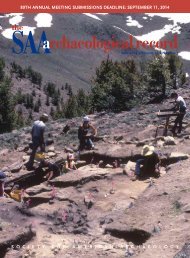SAA
SAA_Record_Nov2015
SAA_Record_Nov2015
You also want an ePaper? Increase the reach of your titles
YUMPU automatically turns print PDFs into web optimized ePapers that Google loves.
PROS AND CONS OF CONSULTING COLLECTORS<br />
Early on, Kley had a good relationship with the state historic<br />
preservation office, at that time a one-man department. This<br />
changed with the enactment of heritage preservation law and<br />
establishment of a larger heritage preservation office in the<br />
1970s. From then on, every field activity had to be approved,<br />
and conflicts arose when Kley conducted rescue documentations.<br />
Kley’s collection numbers about 80,000 lithic artifacts<br />
and many ceramic finds from over 500 sites. He always<br />
intended to give the materials to the public. Unfortunately,<br />
he never managed to deal with the huge volume of finds, and<br />
much of his material remained unpublished. Thanks to his<br />
heirs, who recognize the value of the collection, an agreement<br />
has been made to transfer the collection to the state.<br />
Helmut Mollenkopf (1929–2009) was a farmer and landowner<br />
on the Swabian Alb who became active in archaeology in<br />
the late 1970s, when land reform led to field consolidation<br />
and road improvements. With his colleague Gerhard Häfele,<br />
he surveyed plowed fields, monitored construction sites, and<br />
reported many new lithic scatters (Kreutle 1994). After<br />
Häfele’s death in 1990, Mollenkopf continued this work,<br />
exploring relationships between Neolithic site locations,<br />
chert outcrops, and water sources on the karst plateau. Mollenkopf<br />
recorded site locations on 1:2500 land registry maps<br />
and collected and bagged artifacts by site or parcel (Figure 2).<br />
He opened his collection to the public and to researchers,<br />
and supported our research by helping to establish needed<br />
contacts and through generous private donations. Mollenkopf’s<br />
collection includes significant materials from five<br />
dense Neolithic surface scatters and many other sites, from<br />
Paleolithic to medieval.<br />
Today, Robert Bollow is active as a volunteer working with<br />
state historic preservation officers on the Swabian Alb. He<br />
has a life-long interest in archaeology and devotes much of<br />
his spare time to surveying fields and monitoring sites in his<br />
area. Bollow uses a hand-held GPS unit, records site locations<br />
on land registry maps, and makes his collections available to<br />
researchers. Some of his major contributions have come<br />
from surveying between and around known sites to document<br />
previously unrecorded lower-visibility artifact scatters.<br />
Since 2010, Bollow has maintained an active blog<br />
(“Umgepflügt” [“plowed up”], http://lesefunde.blogspot.com)<br />
that reports on his archaeological activities and discusses a<br />
wide range of archaeological topics. The blog points to the<br />
potential of the Internet for increasing public awareness of<br />
cultural heritage protection law. For example, several posts in<br />
2015 present information about heritage preservation law<br />
and volunteer programs.<br />
Figure 2. Helmut Mollenkopf participating in surface survey, 2006.<br />
Photo by S. Harris.<br />
Lessons from Three Generations on the Swabian Alb<br />
Under changing historical conditions, Kley, Mollenkopf, and<br />
Bollow each made substantial contributions to the archaeology<br />
of the Swabian Alb. All three amassed private collections<br />
that fulfilled then-current standards of documentation. Each<br />
added significantly to regional site inventories, shared his<br />
knowledge locally, and reached out to professional archaeologists.<br />
Albert Kley’s activities bridged an earlier period of<br />
independent research by private individuals with today’s<br />
preservation-oriented archaeology. His contributions are<br />
now becoming clearer through the engagement of professional<br />
archaeologists and the state historic preservation<br />
office, which is curating the collection. Helmut Mollenkopf’s<br />
activities began when heritage preservation law was already<br />
established and preservation officers were building and<br />
maintaining contact with collectors. Accordingly, he received<br />
support from the state historic preservation office, from artifact<br />
identification to curation supplies. Over nearly a decade<br />
of collaboration, he adapted his methods to the needs of our<br />
project and contributed greatly to its success. His collection<br />
will also be curated by the state historic preservation office.<br />
Robert Bollow combines his activities as a volunteer heritage<br />
steward with his archaeology-focused blog. This keeps him<br />
in touch with a wide circle of interested professionals and<br />
laypeople and offers new opportunities for public outreach.<br />
Not all experiences with private collections in this region<br />
have played out so positively. One large private collection was<br />
thrown away by the owner after a museum refused to purchase<br />
it. Afterwards, however, commentaries published in<br />
the newsletter of a local society helped to educate others<br />
about the scientific value of such collections. Overall, the<br />
willingness of dedicated volunteers to share their work in<br />
November 2015 • The <strong>SAA</strong> Archaeological Record<br />
27




